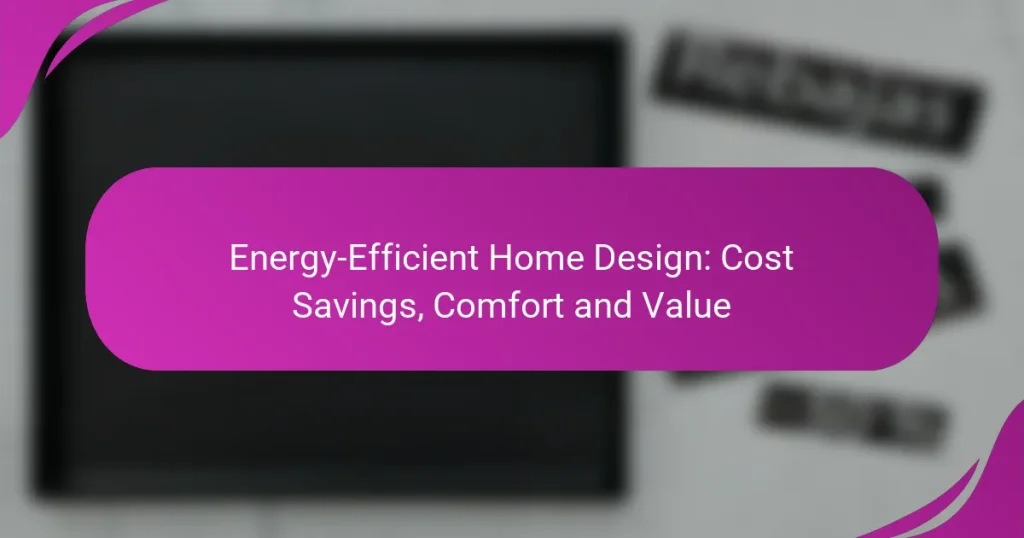Sustainable home design practices focus on creating living spaces that minimize environmental impact while maximizing energy efficiency. By incorporating renewable energy sources and eco-friendly materials, homeowners can significantly reduce their carbon footprint and promote a healthier planet. These practices not only lead to cost savings but also foster a sense of responsibility towards future generations.
Eco-Friendly Home Design: Regional Practices and Innovations
LEED Certification: Requirements, Benefits and Process
Home Design: Carbon Footprint Reduction and Sustainable Living
Sustainable Materials: Selection, Impact, and Aesthetics
Energy-Efficient Home Design: Cost Savings, Comfort and Value
Landscaping: Native Plants, Water Conservation and Aesthetic Value
What are the best sustainable home design practices in Canada?
How can sustainable home design reduce energy costs?
What are the benefits of using renewable energy sources in home design?
Using renewable energy sources in home design offers significant advantages, including reduced energy costs and a lower environmental impact. By integrating these systems, homeowners can decrease reliance on fossil fuels and contribute to a sustainable future.
Solar panel installation
Solar panel installation harnesses sunlight to generate electricity, making it a popular choice for sustainable home design. Homeowners can expect to reduce their energy bills significantly, often by 20-50%, depending on the system size and local sunlight availability.
When considering solar panels, evaluate factors such as roof orientation, shading from trees or buildings, and local regulations. Many regions offer incentives, such as tax credits or rebates, which can offset installation costs, typically ranging from $15,000 to $30,000 before incentives.
Wind energy solutions
Wind energy solutions utilize turbines to convert wind energy into electricity, ideal for homes in areas with consistent wind patterns. Small residential wind turbines can generate enough power to supplement or even fully supply a household’s energy needs, particularly in rural locations.
Before installing a wind turbine, assess your property’s wind resource potential and local zoning laws, as some areas have restrictions on turbine height and placement. Costs for small wind systems can vary widely, generally falling between $10,000 and $70,000, depending on the turbine size and installation requirements.
What certifications are available for sustainable home design?
Several certifications exist to validate sustainable home design, focusing on energy efficiency, resource conservation, and environmental impact. Notable certifications include LEED and Energy Star, each with specific criteria and benefits for homeowners and builders.
LEED certification
LEED, or Leadership in Energy and Environmental Design, is a globally recognized certification system for sustainable buildings. It evaluates a building’s performance based on various criteria, including energy use, water efficiency, and materials selection.
To achieve LEED certification, projects must earn points across several categories. The more points earned, the higher the certification level, ranging from Certified to Platinum. Homeowners should consider the upfront costs versus long-term savings in energy bills and environmental impact.
Energy Star rating
The Energy Star rating is a certification program that identifies energy-efficient products and homes. Homes that earn this label meet strict energy performance standards set by the U.S. Environmental Protection Agency (EPA).
To qualify for an Energy Star rating, a home must demonstrate superior energy efficiency compared to standard homes, often achieving energy savings of 10-20%. Homeowners should look for Energy Star appliances and systems, which can significantly reduce utility costs and environmental footprints.
How to choose sustainable materials for home construction?
Choosing sustainable materials for home construction involves selecting options that minimize environmental impact while ensuring durability and efficiency. Focus on materials that are renewable, locally sourced, or recycled to enhance sustainability in your building projects.
Locally sourced materials
Locally sourced materials are those obtained from nearby suppliers, reducing transportation emissions and supporting the local economy. Common examples include timber, stone, and clay, which can often be found within a few hundred kilometers of your construction site.
When selecting locally sourced materials, consider their availability and the environmental practices of the suppliers. Look for certifications that indicate responsible harvesting or production, such as FSC for wood products or local organic certifications for clay and other earth materials.
Recycled materials
Recycled materials are products that have been repurposed from their original use, significantly lowering the demand for new resources. Examples include reclaimed wood, recycled metal, and repurposed bricks, which can add character and history to your home.
When using recycled materials, ensure they meet building codes and safety standards. Check for any potential contaminants, especially in materials like reclaimed wood, and consider the aesthetic and structural qualities they bring to your design.
What are the challenges of implementing sustainable home design?
Implementing sustainable home design presents several challenges, including higher upfront costs and limited availability of eco-friendly materials. These factors can deter homeowners and builders from adopting sustainable practices, despite the long-term benefits.
Higher upfront costs
One of the primary challenges of sustainable home design is the higher initial investment required. Eco-friendly materials and energy-efficient systems often come with a premium price tag, which can range from 10% to 30% more than traditional options.
Homeowners should consider the long-term savings on energy bills and maintenance costs when evaluating these upfront expenses. For instance, investing in solar panels may seem costly initially, but it can lead to significant savings over time.
Limited availability of materials
The availability of sustainable materials can be a significant hurdle in sustainable home design. Many eco-friendly products, such as reclaimed wood or low-VOC paints, may not be readily accessible in all regions, leading to delays and increased costs.
To overcome this challenge, homeowners can research local suppliers who specialize in sustainable building materials. Additionally, using alternative materials that are locally sourced can help reduce transportation emissions and support the local economy.
How does sustainable home design impact indoor air quality?
Sustainable home design significantly enhances indoor air quality by utilizing non-toxic materials and incorporating effective ventilation systems. These practices reduce pollutants and allergens, creating a healthier living environment.
Use of Non-Toxic Materials
Choosing non-toxic materials is crucial for improving indoor air quality. Common choices include low-VOC (volatile organic compounds) paints, natural fiber carpets, and formaldehyde-free cabinetry. These materials emit fewer harmful chemicals, contributing to a cleaner atmosphere inside the home.
When selecting materials, look for certifications such as Green Seal or Greenguard, which indicate lower emissions. This can help ensure that your home remains free from harmful substances that can affect health.
Effective Ventilation Systems
Implementing effective ventilation systems is essential in sustainable home design. Proper ventilation helps to circulate fresh air and remove indoor pollutants. Options include energy recovery ventilators (ERVs) and heat recovery ventilators (HRVs), which efficiently exchange stale indoor air with fresh outdoor air.
Consider installing exhaust fans in areas like kitchens and bathrooms to further enhance air quality. Regular maintenance of these systems is vital to ensure they function correctly and continue to provide clean air.
Indoor Plants for Air Purification
Incorporating indoor plants can significantly improve air quality by naturally filtering toxins. Plants such as spider plants, peace lilies, and snake plants are known for their air-purifying abilities. They absorb carbon dioxide and release oxygen, contributing to a healthier indoor environment.
For optimal benefits, place several plants throughout your home, particularly in rooms with limited ventilation. Ensure they receive adequate light and care to thrive, maximizing their air-cleaning potential.






